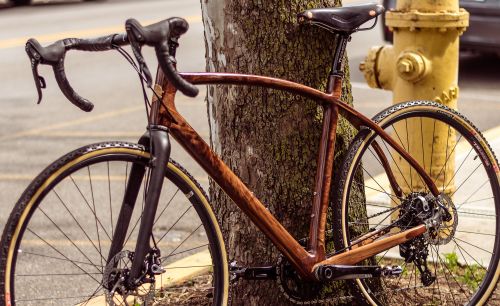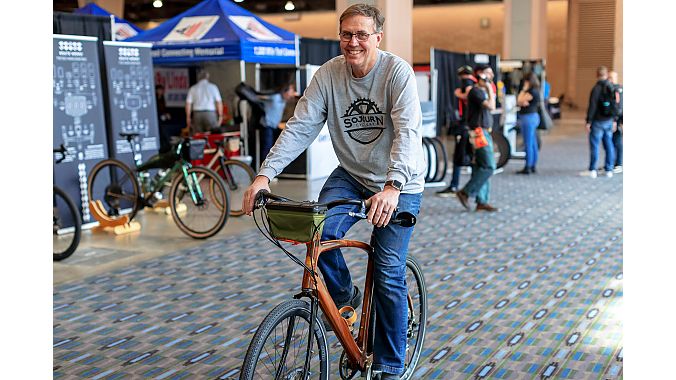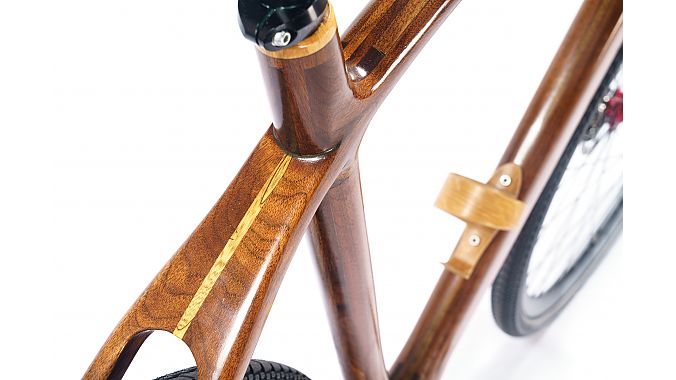A version of this feature ran in the July issue of BRAIN.
CEDARVILLE, Ohio (BRAIN) — Sojourn Cyclery has been at trade shows before, but for the first time at the two-day Philly Bike Expo in March, owner Jay Kinsinger set up a workshop at his booth to give attendees a tiny glimpse of what goes into manufacturing a custom wooden frame.
Crowds both days enveloped the space, watching Bicycle Club of Philadelphia President Chuck Herbert work on his personal frame in a stand, meticulously sanding it.
"That was kind of like a magnet," Kinsinger said in June from his home in Cedarville. "People are just intrigued by that. We had a nice location, and he was one of my best salesmen. He was just talking it up. I also did a seminar on Sunday, and it drew well. That was a great show. The exposure was great."
Intrigued with framebuilding and bike touring for most of his life, Kinsinger, 64, built his first frame — lugged steel — from a kit when he was 20. He went on to become an engineer and currently is associate professor of mechanical and biomedical engineering at Cedarville University while continuing to be active in bike touring and woodworking.
He became curious about wood — specifically walnut — for frame manufacturing when someone showed him a picture of a Renovo wooden bike. "I've always been into woodworking, and, of course, bicycles. And I saw this as a nice convergence of two things that I love. My first frame took about 400 hours and about $300 to make. I did it all by hand. Well, using a hand-operated router and gouges and chisels and things like that. It just took forever. But, you know, when I finished it, I was amazed at the ride. And I've ridden steel frames for tens of thousands of miles. I considered that kind of the gold standard. But this (walnut frame) is unbelievable. To use a geeky engineering word, it's viscoelastic."
The creation process was more organic and ethereal than working with metal, he added.
"To me, it's more fun to work with wood," Kinsinger said. "It has a nice smell, and when you're working with metal all day, you go home and you've got to take a shower. It just sticks to you. Plus, you can do these nice organic curves with the wood that, you could do in metal, but it'd be really hard. And everything can be unique. I can change the sizes and dimensions with just a few button clicks (with a CAD program). So if somebody comes in and they want a shorter top tube, for example, I can easily accommodate that."
PBS show documented Sojourn
Kinsinger, who was featured in an episode of the PBS show "The American Woodshop" in 2018, begins by creating the two clamshell halves with CAD, one of the classes he teaches at Cedarville University. They are bonded together with 3M DP 420 epoxy. Metal inserts are created to support headset bearings, the bottom bracket, dropouts, and seat tube. After sculpting and sanding, penetrating oil is applied, the same as used on gun stocks. "It seeps down into the wood and actually strengthens it, kind of case-hardens it a little bit," he said.
Repairs for gouges or scratches can be made easily, Kinsinger added.
"My son and I were riding the (Sojourn Cyclery) Duo tandem on the Underground Railway Trail from Biloxi (Mississippi) to Lake Erie, and I had it leaning up against a telephone pole and it fell. The top tube got really scarred up badly. And I didn't do anything about it right away. It was just kind of an ugly scrape. But when I got home, I just sanded it down and put some more oil finish on it, which you can just do with a glove. And now you can't tell at all that it happened. With a metal frame, you're talking probably a couple grand to have it refinished. And, if it's a dent, then it's going to stay there."
Kinsinger sells complete bikes with a choice of build kits; in addition to the Duo tandem ($6,800 frame only, not including build kit), he has an all-around model, the Diverso ($3,800 frame). Bikes sold per year vary, he said, while adding last year he had no orders, but so far this year 10.
Make your own frame
He also holds about two workshops a year for up to three students at a time over a long weekend for $2,500 per person, including all materials and tools. The students provide fit measurements in advance, and Kinsinger manufacturers each of them clamshell halves that the students will bond and finish. At the workshop's end, the frame still requires more coats of penetrating oil, with each taking a day to cure, Kinsinger said.
Overall, wood manufacturing offers a less steep learning curve than metal with, of course, no welding skills required.
"They come in at the point where we're gluing the halves together, putting it on the fixture," he said. "And we do all that in a couple hours. If they come on a Friday night, we can have it glued up on the fixture. The next day, it's cured and that's when the finishing happens — lots of sanding and rasping and sculpting."
"If you're on a club ride right next to a carbon fiber frame, it kind of resonates and makes a little kind of humming noise. Well, this doesn't do that. Some call it the Stradivarius of bicycles."
Walnut was the wood of choice for a few reasons, according to Kinsinger. South Central Ohio, where Cedarville is located, has an abundance of it, it's attractive, and it has a superior strength-to-weight ratio that resists splitting.
"It is very well proven in the field of firearms," Kinsinger said. "Most guns have walnut stocks. It's nice to carve. It's not the only wood that can be used, but it's the one that I chose."
His customers, both from workshops and online buyers, know they have an intriguing product when they get it out on the road.
"You can't be too shy to ride one," Kinsinger said. "You go on club rides and it's like you can't even go to the bathroom because you're answering questions all the time. And some will say, 'Wow, what a great paint job' (not realizing it's wood). There's a kind of a shock factor. A lot of people doubt how strong it is, so there are doubters for sure. But they all almost universally declare how beautiful it is. And when they ride it, usually they are impressed, as was I, with how smooth it is and quiet. If you're on a club ride right next to a carbon fiber frame, it kind of resonates and makes a little kind of humming noise. Well, this doesn't do that. Some call it the Stradivarius of bicycles."
The walnut capital
Kinsinger's walnut supply is locally sourced, with some South Central Ohio walnut exported to Germany for cuckoo clocks.
"I was on that PBS show with my students, and often when it reruns, someone will call and say, 'I've got this nasty walnut tree in my yard. I can't grow anything under it. You can have it.' Most recently I had a huge walnut tree given to me because it was blown over in a tornado. It's not exactly free because I have to process it, but it's probably less than most people have to pay for walnut."
Kinsinger is planning to retire from Cedarville University next year to devote more time to Sojourn Cyclery and offer more workshops. He's realized it's time to follow his passions, especially now that he's in remission from a prostate cancer diagnosis in 2021.
"I'm starting to become an old curmudgeon, I guess, because I'm losing my patience," he said. "And I say the kids are changing, but really it's probably me more than them. I'm ready to hang up the cleats and do this."






